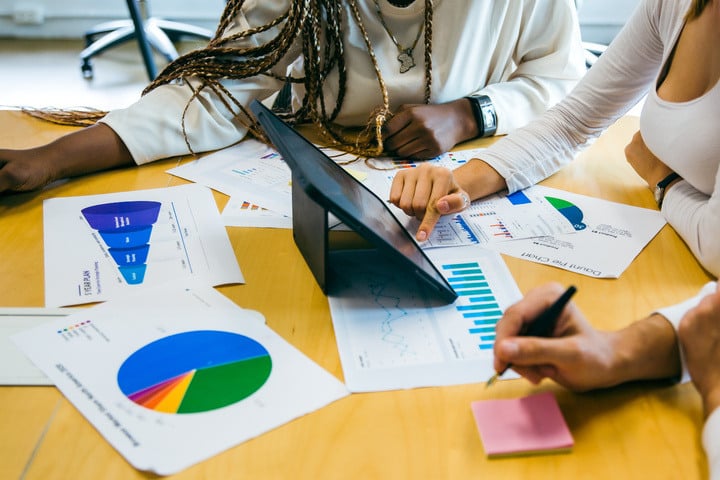HR used to rely on instincts and experience to make workforce decisions. Now, data is changing the game. Imagine knowing which employees are likely to leave months before they resign or spotting hiring patterns that reveal what makes a candidate excel. These insights are valuable in today’s job market and could put you much higher than your competitors.
That’s why people analytics is becoming a top priority for HR leaders. By utilizing AI, companies can track workforce trends, predict turnover, and improve hiring decisions with real-time, data-driven insights—no more guesswork—just smarter, more strategic workforce planning.
What is People Analytics?
People analytics uses data and AI-driven insights to optimize workforce management. Instead of relying on assumptions or one-off employee surveys, AI continuously analyzes trends, predicts challenges, and provides actionable insights.
Traditional vs. AI-Driven People Analytics
Old Approach:
- Performance reviews conducted infrequently
- Employee engagement surveys with delayed or incomplete feedback
- Decisions based on managerial intuition rather than data
AI-Driven Approach:
- Continuous data analysis tracking engagement, productivity, and workforce trends
- Predictive modeling to identify turnover risks and hiring success factors
- Personalized recommendations for improving retention and workforce planning
With AI, HR leaders don’t just analyze the past—they anticipate the future.
Predicting Turnover Before It Happens
Employee turnover is one of the biggest challenges HR leaders face. When a key employee leaves, companies lose more than just talent—they incur recruiting, onboarding, and training replacement costs.
Worse, turnover can lower morale and disrupt team productivity. That’s why proactive solutions are essential. AI-powered people analytics identifies early warning signs and helps HR take action before employees leave.
How AI Predicts Employee Turnover
- Declining engagement, measured by participation in meetings and internal communications
- Productivity shifts, such as inconsistent performance or missed deadlines
- Work pattern changes, including increased absenteeism or reduced collaboration
- Sentiment analysis of workplace interactions to detect dissatisfaction
- Benchmarking against past turnover data to identify flight-risk employees
Taking Action Before It’s Too Late
Once AI flags at-risk employees, HR teams can intervene with targeted retention strategies, such as:
- Career development opportunities – Training or mentorship programs to keep employees engaged
- Compensation reviews – Ensuring salaries and benefits remain competitive
- Work-life balance improvements – Addressing burnout by adjusting workloads or offering flexible schedules
KPMG employed AI analytics tools to predict two-thirds of employees likely to resign and successfully retained 10% to 20% of them through targeted interventions. By identifying employees who showed early signs of disengagement, the company implemented personalized retention initiatives—such as career growth conversations and workload adjustments—before employees started seeking other jobs.
Improving Hiring Decisions with AI
Hiring the right talent has always been a challenge. Even with structured interviews and skill assessments, bias, inefficiency, and misalignment between candidates and job needs often result in costly hiring mistakes. AI-powered people analytics removes guesswork and makes the hiring process smarter, faster, and more effective.
How AI Enhances Hiring
- Identifying top-performing employee traits based on past hiring data
- Matching candidates to roles based on skills, cultural fit, and predictive success rates
- Reducing bias by standardizing candidate evaluations and removing demographic details
An example of a company that has found success in its hiring process with AI is Chipotle. Chipotle implemented an AI-powered virtual assistant, Ava Cado, to streamline their hiring process. This innovation increased application completion rates from 50% to over 85% and reduced the average time-to-hire from 12 days to just 4 days. Chipotle significantly improved efficiency and hiring speed by leveraging AI to optimize recruitment.
Tracking Workforce Trends for Better HR Strategies
Workforce dynamics constantly shift, and staying ahead of trends is crucial for HR leaders. AI-powered people analytics helps companies identify patterns in employee behavior, engagement, and productivity—turning raw data into actionable insights.
Key Workforce Insights from AI
- Detecting burnout risks by monitoring workload patterns and stress indicators
- Comparing remote vs. in-office productivity to refine work policies
- Optimizing team structures based on collaboration patterns and efficiency data
These insights help HR improve work-life balance, enhance collaboration, and increase engagement through data-backed decisions.
The Future of People Analytics: AI’s Expanding Role
AI redefines how companies manage their workforce, but its impact is just beginning. As AI continues to evolve, HR is shifting from a reactive function—fixing issues after they arise—to a proactive one, predicting and preventing problems before they happen.
From Reactive HR to Proactive HR
- Predicting workforce trends before they affect productivity
- Identifying turnover risks early to implement retention strategies
- Anticipating hiring needs based on business growth projections
AI as a Strategic Partner in Workforce Planning
- Optimizing staffing levels by forecasting talent needs
- Improving leadership succession planning
- Enhancing employee development through personalized career growth strategies
What’s Next for AI in People Analytics?
- Real-time workforce monitoring for immediate adjustments
- More accurate predictive analytics for retention and performance forecasting
- Greater personalization in employee experience, learning, and career growth
HR teams that leverage AI will gain a long-term competitive advantage in workforce management.
Unlock the Full Potential of Your Workforce with AI-Driven Insights
Data-driven HR decisions are no longer optional but essential for staying competitive. With AI-powered people analytics, companies can hire smarter, retain top talent, and optimize workforce productivity with real-time insights.
Discover how Fuse Workforce Management empowers HR leaders to make confident, data-backed workforce decisions.
